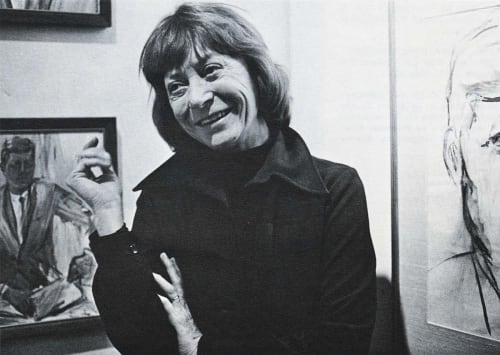Born in 1918 in Brooklyn, Elaine de Kooning was exposed to art through frequent museum and gallery visits with her mother from a young age. Shortly after enrolling at Hunter College, New York, she withdrew in 1937 and began studying art at the Leonardo da Vinci Art School, New York, with Conrad Marca-Relli, who became a close friend. She also took drawing classes from the man who would eventually become her husband, Willem de Kooning, in 1938. Her early works are still lifes and portraits distinctly influenced by Cubism, but in the mid- to late 1940s she began making abstract paintings as well as writing art criticism. She worked as an editorial associate at Art News under Thomas Hess, writing essays on Arshile Gorky, Hans Hofmann, and Franz Kline, and making Abstract Expressionism accessible to a broader audience. In 1948, De Kooning spent the summer at Black Mountain College near Asheville, North Carolina, where she played the title role in a production of Erik Satie’s Le piège de Méduse (The Ruse of Medusa, 1948) for which she also designed the sets. Her first solo exhibition was in 1952 at the Stable Gallery, New York, where she showed again in 1954 and 1956.
De Kooning was a founding member of the Club, a group of avant-garde artists that met in Greenwich Village to discuss and debate art from 1949 until 1962. Though a fierce defender of Abstract Expressionism, she eventually became known for her portraits, particularly of men. After receiving a teaching appointment at the University of New Mexico, Albuquerque, in 1958, she traveled to Ciudad Juárez, Mexico, where she saw her first bullfight. The experience inspired a series of bull paintings on horizontal canvases, rendered in a bolder palette than that of her previous work. In 1961 she was included in the Whitney Annual (later the Whitney Biennial), New York, and in 1962 was commissioned to paint John F. Kennedy’s portrait, in part because of her reputation for quick execution. In 1983 she visited the Paleolithic caves in Lascaux, France, and began a series of paintings based on the cave paintings, titled Cave Walls, in which outlines of animals such as deer, bison, and goats, are rendered against turbulent grounds of dense brushstrokes.
De Kooning had several solo gallery shows throughout her lifetime at museums including the Montclair Art Museum, New Jersey (1973), and Guild Hall Museum, East Hampton, New York (1989). Her work was featured in the Museum of Modern Art–organized exhibition, Young American Painters (1956–58), which traveled throughout the United States (but was not presented in New York). De Kooning was also included in group shows at Walker Art Center, Minneapolis (1956); Pittsburgh International (now Carnegie International, 1956); Art Institute of Chicago (1964); Hirshhorn Museum and Sculpture Garden, Washington, D.C. (1980); and Guild Hall Museum, East Hampton (1990). De Kooning died on February 1, 1989, in Southampton, New York.
